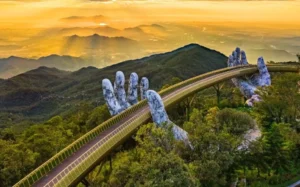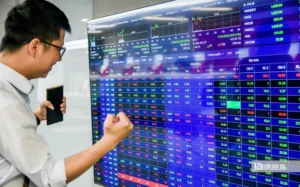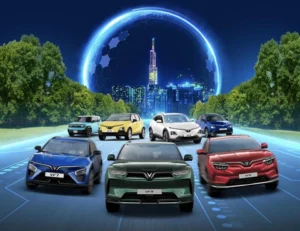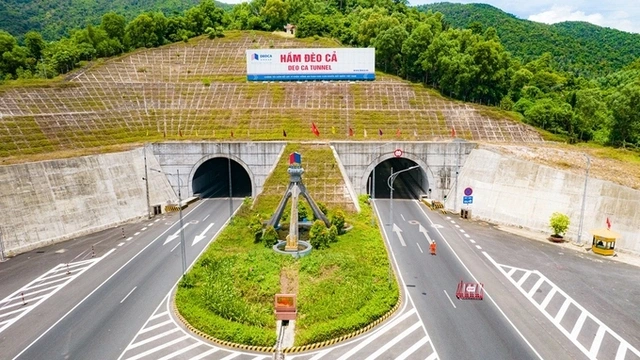From being just subcontractors, many Vietnamese enterprises have quickly mastered technology and science to undertake large projects.
From the “chronic disease” of slow progress, Vietnam has had “speed kings” in constructing difficult infrastructure projects … In the past two decades, millions of private enterprises have contributed greatly to economic growth, creating miracles that the world admires.

Photo: Contributor
King of speed, king of tunneling
On August 18, from the main bridge at the Khanh Hoa – Buon Ma Thuot expressway project in Dak Lak province, Prime Minister Pham Minh Chinh launched the peak emulation campaign “500 days and nights to complete 3,000 km of expressway “. 500 days and nights, less than 1.5 years for nearly 1,000 km of expressway to complete the 3,000 km expressway strip from North to South is an unimaginable goal, if looking back 2 decades ago. In 2004, the first expressway in the southern area of Ho Chi Minh City – Trung Luong was only 40 km long but took 6 years to build. At this speed, in 500 days, we can only build about 10 km of expressway.
However, the “speed king” – Son Hai Group, on behalf of the investors, has committed to completing and putting into operation 3,000 km of expressway before December 31, 2025, in accordance with the target set by the Prime Minister. And if Son Hai Group undertakes, it will be a guarantee for the construction progress of any project. Because since its presence in the construction market, this contractor has “stamped” its reputation and brand based on two unique factors: progress and quality. Up to now, Son Hai is the only infrastructure contractor in Vietnam that has committed to a 5-10 year quality warranty at construction projects. Son Hai is also the contractor awarded the title of “speed king” in a market where the “disease” of slow progress has become chronic.
For example, earlier this year, this group made domestic and foreign enterprises admire its journey to build the “wonder” of a 1,200 billion VND mountain tunnel (part of the North-South expressway, Nha Trang – Cam Lam section) 6 months ahead of schedule. The Doc San tunnel project began construction in November 2021 with a 1,480 m long mountain tunnel including 2 complete parallel tunnels, each tunnel is more than 700 m long, the progress milestone that the investor committed to complete in January 2023 is considered a huge challenge.
However, with more than 500 pieces of equipment, 1,500 workers, divided into 3 shifts working day and night, and applying the world’s leading modern NATM construction technology, Doc San tunnel was officially opened to traffic in May 2022, 6 months ahead of schedule, contributing to bringing the entire Nha Trang – Cam Lam route to the finish line 3 months early, creating a miracle in the domestic transport construction industry . Previously, Son Hai Group also proactively proposed to reduce the construction time of Bien Hoa – Vung Tau expressway from 36 to 24 months. These are very rare stories, especially in the picture of chronic delays in the general transport infrastructure construction market in Vietnam.
If Son Hai made a miracle with Doc San tunnel, Deo Ca tunnel is the first milestone that made the name of “tunnel king” Ho Minh Hoang – Chairman of Deo Ca Group. At the time the head of the group hatched the idea of building Deo Ca tunnel, in Vietnam there was only Hai Van tunnel project. The design and construction were completely dependent on foreign units. Because mountain tunnels are very difficult projects in terms of engineering, rugged terrain, and huge investment costs. Many domestic and foreign investors had to “leave” after researching. With the aspiration to build a lifeline connecting the Central region with the Central Highlands, Mr. Ho Minh Hoang boldly proposed the idea of building a road tunnel through Deo Ca mountain.
It must also be said that Deo Ca is famous as one of the most dangerous passes in our country, located on the border of Phu Yen and Khanh Hoa, cutting across Dai Lanh mountain. Compared to other passes, Deo Ca is not long, only about 12 km but dangerous because of the slope and curves. This is also the place where many tragic accidents occur, especially on crowded passenger buses. But that is also one of the reasons why the head of Deo Ca Group is determined to carry out his idea even though he has never dug a tunnel or carved a mountain before.
“I remember at the time of the Deo Ca tunnel construction, for a foreign engineer, the company had to pay 20,000 – 30,000 USD/month, a very large number. With this number, we could pay salaries for 8 – 10 experienced Vietnamese engineers. However, without such prices, along with a great aspiration, great determination, we would not have had the Deo Ca tunnel project and quickly after that, there would have been Cu Mong, Hai Van 2 tunnels… and perhaps until now, Vietnam still has to hire foreign experts to do domestic tunnel projects at foreign prices”, Mr. Ho Minh Hoang shared.
After Deo Ca tunnel, there are Cu Mong and Co Ma road tunnels in Phu Yen and Binh Dinh ; Hai Van 2 tunnel (Da Nang), Trung Luong – My Thuan expressway, Dong Dang – Tra Linh expressway, Huu Nghi – Chi Lang, Bao Loc – Lien Khuong… The name “tunnel king” has been associated with businessman Ho Minh Hoang since then.

PHOTO: THANH XUAN
Besides the two prominent names mentioned above, along the length of the country, there are many highways bearing the mark of Vietnamese spirit and Vietnamese aspirations. Not many people know that behind the picturesque Ha Long – Van Don – Mong Cai highway is an amateur in this field – Sun Group, while VinGroup has made its name in the North – South axis road system of Phu Quoc Island ( Kien Giang )… Thanks to that, in just over 3 years, the whole country has completed and put into operation 858 km of highways, equal to more than 2/3 of the highway length built in nearly 20 years ago.
Vietnam has “bread of industry”
Steel is not only a symbol of industry in many developed countries in the world but also helps many countries become superpowers.
US Steel, a 120-year-old American steel corporation before it was sold to Japanese steel in 2023, is a typical example. In the early 20th century, US Steel provided steel not only for skyscrapers, bridges and dams but also for cars, appliances and other products that American consumers needed. Thanks to that, US Steel once became the most valuable company in the world and helped the US become a global economic superpower. In Asia, Posco is a symbol of Korea, a symbol of the indomitable will to overcome all difficulties, turn challenges into opportunities, and develop a rich economy from the ashes of war and the end of hardship.
In 2024, Vietnam will be on the map of the global steel industry when it has a company in the top 15 steel companies with the largest capitalization in the world steel industry. In particular, Vietnam will also officially produce HRC steel, upstream steel, the most important input material for manufacturing and manufacturing industries such as mechanics, shipbuilding, automobile and motorbike manufacturing, household appliances manufacturing, defense industry, mining industry, electricity industry, etc., ending the complete dependence on imports.
It is worth mentioning that before becoming the largest steel producer in the ASEAN region, we had a very late starting point. It was not until 1963 that Vietnam had its first batch of pig iron. 12 years later, in 1975, we had our first batch of steel produced at the Thai Nguyen Iron and Steel Company . During the period from 1975 to 1990, the Vietnamese steel industry developed very slowly, mostly using steel from Eastern European countries and the Soviet Union, with output during this period remaining at 40,000 – 80,000 tons/year. However, Vietnamese steel has accelerated with the participation of private enterprises and up to now, Hoa Phat has become a symbol of Vietnamese steel. Not only is it the first and only Vietnamese enterprise to date to produce HRC hot-rolled steel, Hoa Phat Group Chairman Tran Dinh Long said that Hoa Phat is researching silicon steel to produce steel used in electric motors and made from scratch. This is a product that no other company in Vietnam has been able to produce. In addition, Hoa Phat also plans to produce high-strength rail steel. The group has taken the first steps and is ready to bid for the North-South high-speed railway project …
Just 5 years ago, no one believed that Vietnam could produce cars, but now, every day, every hour, we can call an electric taxi of the Green SM brand, a Vietnamese brand car, in a few minutes and with a few steps.

If in the past, domestic contractors were completely outnumbered in biddings in difficult fields such as electricity and ports, now the situation is different. The consortium of Pacific Corporation and Phu Xuan Consulting and Construction Joint Stock Company ( Phu Xuan) has surpassed Japanese and Singaporean contractors to implement the construction of Vinh Tan 4 Power Plant Port and Vinh Tan 4 expansion ( Binh Thuan ). From the success of the above two projects, the Pacific Corporation – Phu Xuan contractor consortium continued to win the bid for the investment package to build Van Phong Power Plant Port (Khanh Hoa) worth about 1,300 billion VND invested by Sumitomo Group (Japan).
This is also one of the few large-scale transport infrastructure packages constructed by domestic enterprises. Phu Xuan is also the contractor for the largest deep-water port project in Vietnam – Cai Mep Gemadept – Terminal Link (Gemalink) in Ba Ria-Vung Tau with a contract value of over VND 1,400 billion. Previously, Vinh Tan International Port, invested by Vinh Tan International Port Joint Stock Company, was also constructed by Phu Xuan and Waterworks Construction Consulting Joint Stock Company (WACOSE). This is one of the first deep-water seaports in our country invested and operated by a domestic private enterprise with a capital of over VND 2,000 billion. In particular, the Ha Long international passenger port project – the first specialized port in Vietnam, invested and constructed by the “amateur” Sun Group, has also created an impressive milestone in the development of Vietnam’s seaport infrastructure system.
Creating new games
Mr. Nguyen Duy Hung, former Secretary of the Quang Ninh Provincial Party Committee , recalled that when the bridge connecting the mainland to Van Don was built, the people of this area considered it a miracle. And if only relying on budget capital, it is unknown when Van Don could change its face, and have enough thousands of billions of VND to build an international airport. But everything changed dramatically when Van Don was the first place to have an airport built by the private sector. To date, Quang Ninh is still the clearest evidence of success in mobilizing private capital to participate in a difficult field that has traditionally been only undertaken by the state.

PHOTO: VIVA
The people of Cat Hai ( Hai Phong ) who mainly live on aquaculture, still cannot imagine that the brackish coastal water area has become one of the largest industrial production “bases” in the country in less than 2 years. This is where the first Vietnamese branded automobile factory – VinFast with an investment capital of 4.2 billion USD is located. It is also difficult to find any other word than “miracle” to describe the 650-day effort to construct and complete the first automobile factory in Vietnam, the cradle that made VinFast a national pride on par with the world’s powers.
Looking back after nearly 40 years of renovation, from an unrecognized and restricted position, the private economy in Vietnam has been gradually “unleashed” and gradually become the driving force of economic development.
Economist, Dr. Vo Tri Thanh commented: The clear mark of the Vietnamese economy in recent years is the appearance and rise of large economic groups, including private economic groups. They have contributed to changing the face of the country, creating an impression, enhancing the position and prestige of Vietnam in the international arena, thereby forming many brands that are competitive in the region and the world.
“We clearly see the creative role of VinGroup and Sun Group in bringing about a revolution in Vietnam’s tourism image through world-class projects that make the world admire from coastal areas such as Phu Quoc, Da Nang, Quang Ninh… to the mountainous Sa Pa area. We also see Vietjet Air, the first private airline in Vietnam following the low-cost airline model, contributing to bringing flying opportunities to millions of people with average incomes. Sun Group also participates in the aviation sector. Sun Air – the company’s premium general airline – is also a different phenomenon, showing that it is time for Vietnam to rethink its development methods. It can be seen that private enterprises always have a new vision and direction. They have been, are and will continue to be the driving force leading the Vietnamese economy in new games”, emphasized Dr. Vo Tri Thanh.
















